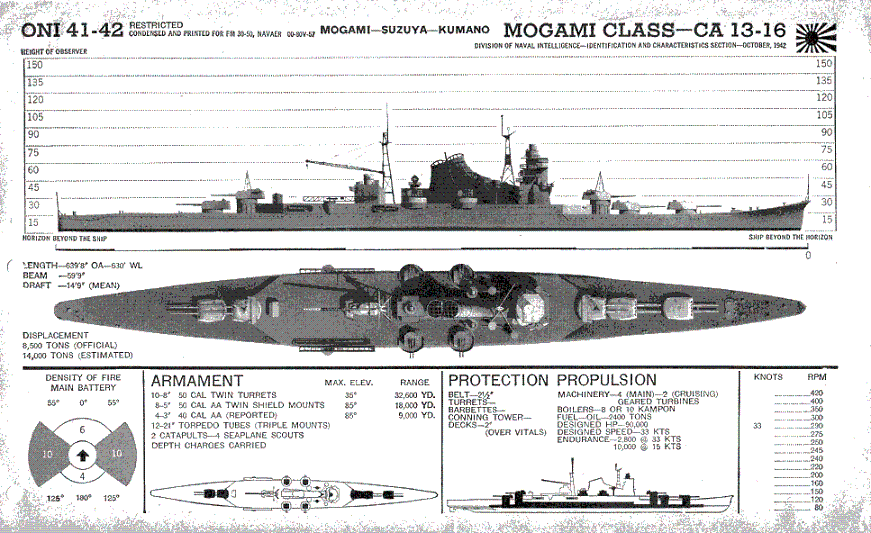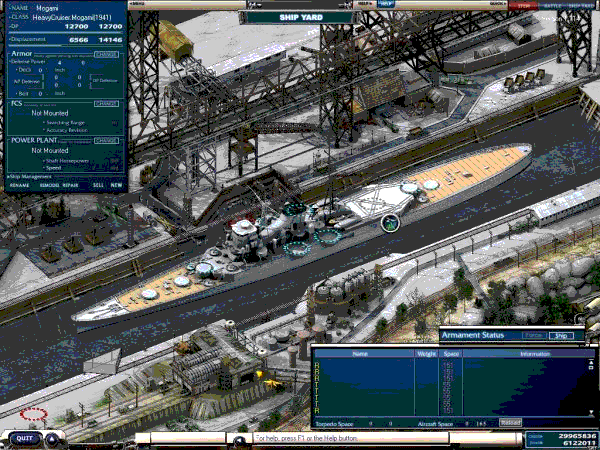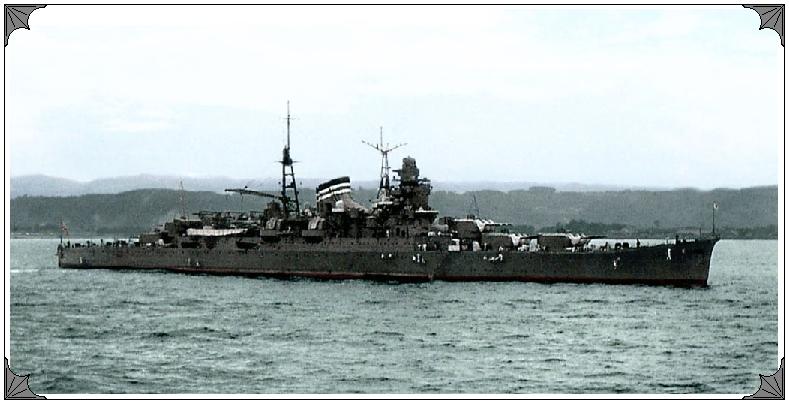
Imperial Japanese Navy - MOGAMI class Crusier ==========================================================================
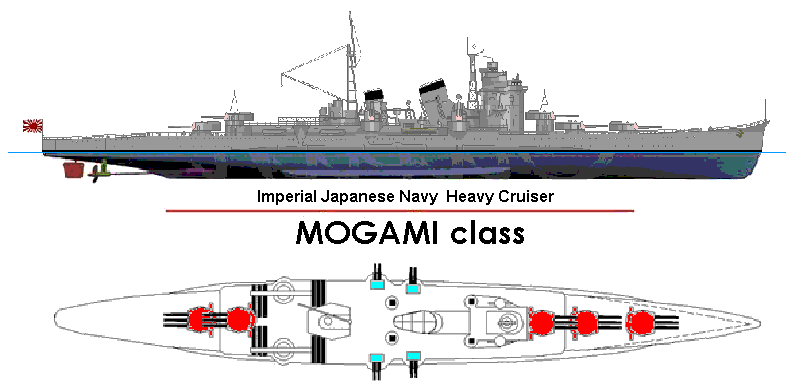
Mogami was the lead ship in the four-vessel Mogami-class of heavy cruisers in the Imperial Japanese Navy. It was named after the Mogami River in Tohoku region of Japan. The Mogami class ships were constructed as "light" cruisers (per the Washington Naval Treaty). They were exceptionally large for light cruisers, and the barbettes for the main battery were designed for quick refitting with twin 8" guns. In 1937 all four ships were "converted" to heavy cruisers in this fashion.
In the years following World War One, the "War To End All Wars", naval construction was limited by international treaty. Like all other naval powers, Japan was restricted to a tonnage limit, with further constraints on the number of vessels of each type.
The Mogami class cruisers were initially laid down as ligh cruisers, yet in actual size were larger than most heavy cruisers of the day. After only a brief period under the categorization as light cruisers, all four ships were equipped with heavier weaponry and re-categorized as heavy cruisers.
The terms "light" cruiser and "heavy" cruiser originated as a convenient method of classification spelled out in the terms of the Washington Naval Treaty. Light cruisers were defined as ships armed with 6.1" guns or smaller, regardless of the ship size. The heavy cruiser was defined as being armed with guns larger than 6.1". In practice most heavy cruisers were armed with 8" guns or their metric equivalents. Under the rules, after the London treaty conference, treaty cruisers were also limited to a tonnage per ship of 10,000. Japan was near her allowed legal limit with regard to heavy cruiser tonnage. The treaty terms did allow for replacement of older ships and several light cruisers were nearing the age where they could be scrapped and replaced with new tonnage. By combining the remaining tonnage allowance, about 12,000 tons, plus tonnage gained by the scrapping of older ships, it was calculated that four new 8,500 ton light cruisers and two additional ships of a modified design could be built and still be in compliance with the treaty agreements. These would become the Mogami class, (4 ships) and the Tone class (2 ships).
In the late 1920's Japan was near her limit of tonnage, but had several light cruisers nearing scrapping. It was decided to build four new light cruisers, using the then revolutionary electric welding to save weight, and to design them from the outset to be capable of conversion to heavy cruisers. These four ships became the Mogami class - Mogami, Mikuma, Suzuya and Kumano. Problems with the welding of the first two ships led to Suzuya and Kumano being completed with a modified design, but all four were nevertheless rather overweight light cruisers.
Built under the 1931 Fleet Replenishment Program, the Mogami-class cruisers were designed by Yuzuru Hiraga to the maximum limits allowed by the Washington Naval Treaty, using the latest technology. This resulted in the choice of 155 mm guns in five triple turrets (a first for Japan), and new impulse geared turbine engines, coupled with very heavy anti-aircraft protection, as well as the standard reloadable, turreted torpedo tubes, (also unique to the IJN),.gave the class a very high speed and protection. However, the Mogami-class was also plagued with technical problems due to its untested equipment, and proved to be top-heavy as well, which created stability issues during poor weather.
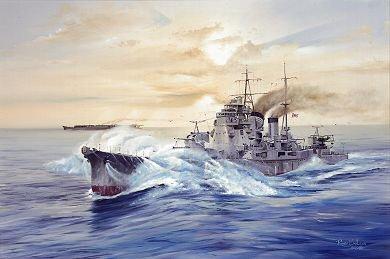
The weight saving attempt by using electric welding in the construction of MOGAMI resulted in a serious weakness. After her high speed trials the hull was found to have suffered warpage, the bow was twisted and the main turrets forward could not be trained. MOGAMI and MIKUMA were both drydocked for extensive reinforcement. These modifications, while lending to stablity, increased their weight and slowed both ships down by 2 knots. KUMANO and SUZUYA were redesigned as a result of the problems encountered in the first two sisters.
This class is seen by naval architects as trying to fit a quart into a pint pot. The IJN's Naval staff insisted that each new class be superior to anything else in its category, this placed an enormous burden on Japanese naval constructors and the difficulties with these ships have to be seen in this light.
The initial construction was extremely light in order to comply with the naval treaties and had to be remedied. When the Royal Navy's Director of Naval Construction (DNC) was told about these ships by British Naval Intelligence quoting the public displacement figure he replied that the capabilities quoted could not be achieved on this displacement and that "they must be building their ships out of cardboard or lying".
These ships win the prize for "Egregious Treaty Violation." The London Naval Treaty of 1930 (a follow-on to the Washington Naval Treaty of 1922) specified that cruisers of all signatory nations were to be held to displacements of 10,000 tons. Mogami, when first built, weighed in at about 13,400 (although I should also mention that some other Japanese CAs had been rebuilt by that point to exceed even this displacement). Not surprisingly, foreign naval observers were a little suspicious about her. Turns out that even given her extra displacement, she was overloaded. When she began running trials, it was discovered that firing all the guns of her main battery simultaneously had the unpleasant effect of popping the welds along her sides. Hmmm... When first launched, these ships were officially classified as light cruisers, because they were armed with 15 x 6" guns. They had been cleverly designed so that the turret base rings would also accept a dual 8" turret when the time came, and all were re-armed this way shortly before the war. Very sneaky...
They were in fact designed from the beginning to be able to be upgraded to 8" gun ships should the political situation allow it. It should be noted that all of these ships were looked upon with considerable suspicion in the West as it was stated by both American and British naval constructors that the TAKAO and NACHI class HAD to be exceeding treaty limits in displacement. When trying to design an equally powerful reply they found it impossible to arrive at the same combination of armor, armament and size and still remain within the 10.000 ton limit. Although officially denied, the Japanese ships were in fact well in excess of the legal treaty limits. Several innovations were tried with the MOGAMIs to reduce weight and attempt to comply with the treaty limitations but without sacrificing any fighting power. Electric welding was used extensively in their construction, a pioneering effort that resulted in serious structural weakness. All of the boiler uptakes were trunked into a large single funnel. After the capsizing of the torpedo boat TOMODZURO during a fleet exercise, the design was revised and top weight was drastically reduced. The original massive bridge, (similar to the TAKAO), as designed for the class was discarded and a new more compact design was built. In spite of these changes the MOGAMIs were still too heavy and were well over the treaty specifications. Soon it would not matter as Japan withdrew from the naval limitation agreements and pursued a new design program free from restraints.
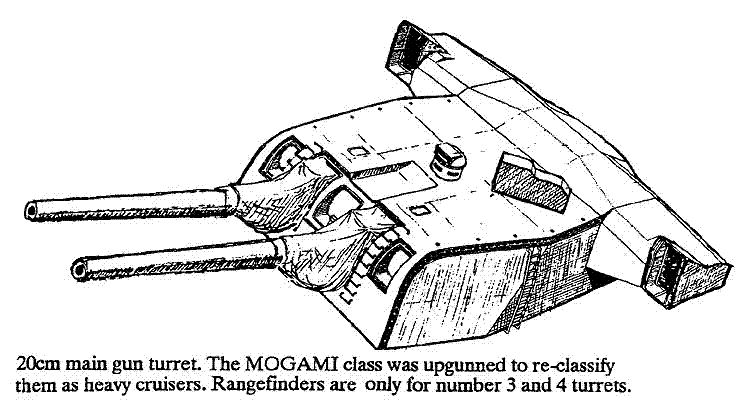
The Mogami cannot be called a lucky ship, as she suffered two collisions with other cruisers: first with Mikuma during the Battle of Midway and two years later with Nachi in the Battle of the Philippine Sea. Additionally, the crew of Fubuki had been accused of launching the torpedo spread that accidentally sank four Japanese transports and a minesweeper, but recent research indicates Mogami the more likely agent.
But what a splendid ship! With ten 8-inch guns and able to make 35 knots, she was faster than any battleship and could blow anything smaller out of the water. It's a great concept, and not a new one. Essentially that was the design philosophy behind the USS Constitution and her sister "heavy frigates" of the late Eighteenth Century; they could out-sail any British ship-of-the-line, and could out-gun anything else. But Mogami's career was considerably shorter-lived than Constitution's.
At the battle of Midway, Mogami was very nearly sunk, and it was decided to rebuild her as an a hybrid cruiser/carrier to carry additional float planes.
Following the loss of several Japanese flattops at the Battle of Midway, and what was thought to be the growing obsolescence of surface ships due to their vulnerability to aircraft as seen at Pearl Harbor, and the loss of Force Z. The Imperial Japanese Navy decided to convert several of its surface warships to hybrid Strike Carriers meant to bridge the gap between carriers and surface ships.
Originally the naval staff outlined a plan to convert all of the Emperorís battleships and heavy cruisers to carriers (except for the pair of huge 18" gunned Yamato class behemoths). Proving over-ambitious only the damaged heavy cruiser Mogami and a pair of 25-year old Battleships (Hyuga and Ise ) were actually converted.
From that point on until her sinking on 25 December 1944, Mogami carried a complement of aircraft as the war progressed. As you probably gathered from comments on Ise and Hyuga, I'm not very impressed with this move, because none of these hybrid ships were very useful as aviation vessels. I find it ironic that Mogami's last action was to be sunk at the hands of the same U.S. battleships that sank Fuso and Yamashiro in Surigao Strait. Apparently, she was useless enough as an aviation vessel that she wasn't even included in Ozawa's sacrificial carrier bait force, but was relegated to surface combat duty with the two oldest BBs in the Japanese Navy.
None of the ships survived the war. The Mogami was sunk by American torpedo-bombers at the Battle of Surigao Strait. Her sister ships, the Suzuya and Kumano were sunk within a month of each other, the former in October 1944 at the Battle of Samar by carrier borne aircraft and the latter by American bombers in the Dasol Bay, Philippines, in November 1944.
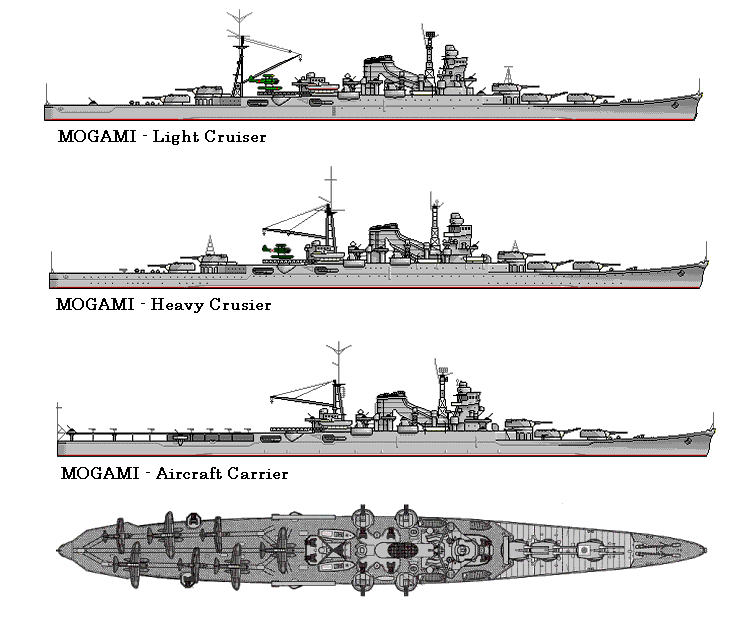
=================================================================================
NB: The above text has been collected / excerpted / edited / mangled / tangled / re-compiled / etc ... from the following online sources :
IJN - Mogami Class Crusier - wikipedia article #1
IJN - Mogami Class Crusier - wikipedia article #2
IJN - Mogami Class Crusier - www.globalsecurity.org
IJN - Mogami Class Crusier - smmlonline.com article #1
IJN - Mogami Class Crusier - smmlonline.com article #2
IJN - Mogami Class Crusier - www.combinedfleet.com
IJN - Mogami Class Crusier - www.acepilots.com
